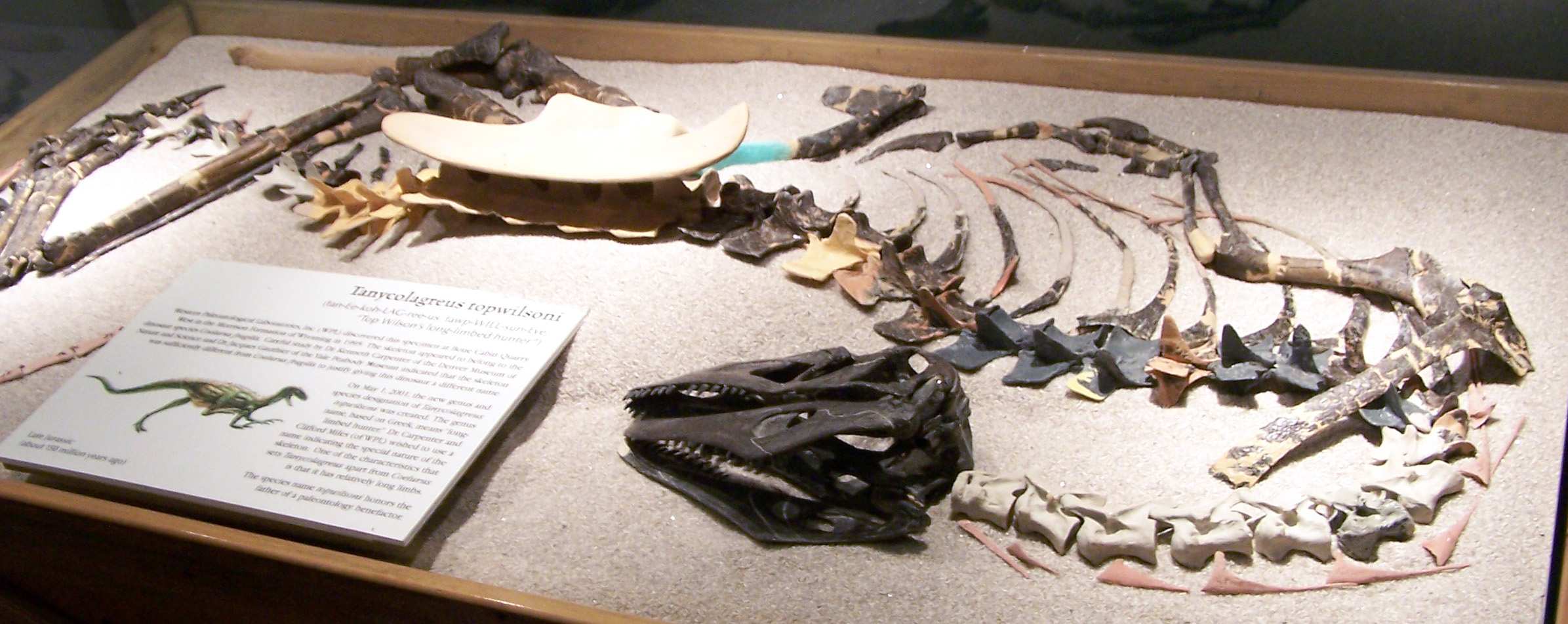- Tanycolagreus
Taxobox
name = "Tanycolagreus"
fossil_range =Late Jurassic
regnum =Animal ia

image_width = 250px
image_caption = "Tanycolagreus" fossil cast, North American Museum of Ancient Life.
phylum = Chordata
classis = Sauropsida
superordo =Dinosaur ia
ordo =Saurischia
subordo =Theropoda
unranked_familia =Coelurosauria
familia =Coeluridae ?
genus = "Tanycolagreus"
genus_authority=Carpenter "et al.", 2005
subdivision_ranks=Species
subdivision=
*"T. topwilsoni" Carpenter "et al.", 2005 (type)"Tanycolagreus" is a
genus of coeluridtheropod from the LateJurassic ofNorth America . Theholotype is a partial skeleton recovered from theBone Cabin Quarry West locality, Albany County,Wyoming , from theMorrison Formation (Oxfordian-Tithonian ). The holotype (TPII 2000-09-29,Thanksgiving Point Institute, Inc.) includes an incomplete skull andmandible s and much of thepostcrania l skeleton, and two paratypes have also been named — an incomplete hand originally referred to "Ornitholestes hermanni", also collected from Bone Cabin Quarry, and apremaxilla , originally referred to "Stokesosaurus clevelandi", from theCleveland-Lloyd Quarry ofUtah . The skull of "Tanycolagreus" is less well known than its postcranialanatomy , and only the following elements have been found: leftnasal , leftlacrimal , leftpremaxilla and one premaxillary tooth, leftpostorbital , leftquadratojugal , incomplete leftsquamosal , right quadrate, rightsplenial , left articular, and two cheek teeth. Theetymology of "Tanycolagreus" is based upon the structure of its long forelimbs ((Greek "tany" - 'long, stretched out', "kolon" - 'limb' and "agreus" - 'hunter'); the species is named for George "Top" Wilson. Carpenter "et al." (2005, pp. 43-44) determined that the holotype of "Tanycolagreus" represents a subadult individual which measured approximately 3.3 meters (11 ft) long in life. However, one of the paratypes, the premaxilla from the Cleveland-Lloyd Quarry, would have belonged to a larger individual, measuring 4 meters (13 ft) long. It cannot be determined whether or not the Cleveland-Lloyd specimen represents a fully mature adult, so the upper size limit for thetaxon remains unknown. Though a detailedphylogenetic analysis of "Tanycolagreus" has yet to be carried out, Carpenter "et al." (2005, p. 44) state that, of the other known Morrison theropods, this genus most closely resembles "Coelurus ", though it retains more primitive features. A life restoration of "Tanycolagreus" is on display at the North American Museum of Ancient Life (Lehi, Utah), where it is portrayed as preying upon a smallornithischia ndinosaur , "Othnielia rex".Diagnosis & Description
Carpenter "et al." (2005; pp. 27 & 29) diagnosed "Tanycolagreus topwilsoni" as follows: "Medium-sized tetanuran having short, deep-bodied premaxilla pierced by narial
foramen at base of nasal process, orbital process on postorbital, T-shaped quadratojugal, centrodiapophyseal lamina on dorsals. Differs from "Coelurus" in the absence of pleurocoel on anterior dorsals; posterior caudal prezygapophyses elongated to one-third centrum length, rather than short; straight, rather than sigmoidal, humeral shaft; bowed, rather than straight, radius; flat-bottomed rather than arced pubic foot; straight rather than sigmoidal femoral shaft;metatarsal length subequal to humeral length, rather than 1.75 times humeral length. Differs from "Ornitholestes" in straight anterior margin of premaxilla, rather than rounded; T-shaped rather than L-shaped quadratojugal; elongate neural spine; posterior caudal prezygapophyses only one-third centrum length, rather than one-half centrum length; bowed, slender radius, rather than straight, robust radius." The single premaxillary tooth preserved with the holotype is badly damaged, but does exhibit the asymmetrical cross-section typical in theropod teeth; the cheek teeth are too poorly preserved to show any detail.References
* Carpenter, K., Miles, C., and Cloward, K. (2005). "New small theropod from the Upper Jurassic Morrison Formation of Wyoming." in Carpenter, K. 2005. "The Carnivorous Dinosaurs", Indiana University Press: 23-48.
Wikimedia Foundation. 2010.
